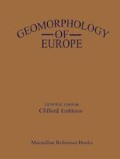Abstract
For a long time, the relationships of the main relief forms to tectonic structure over the area of the Russian platform were interpreted as a passive response to lithology and structure—an expression of differential rock resistance exploited by exogenic processes. The introduction of morphostructural concepts and methods into Soviet geomorphology [see Gerasimov (1946, 1959), Metcherikov (1968)] has provided a new interpretation of the main relief features in terms of tectonic movements and the deeper structures of the Earth’s crust. The tectonic movements that formed the present-day morphostructures were not always in accordance with the tectonic movements of ancient geological periods. Morphostructural analysis of the Russian platform and European lowland supported a theory of the periodic development of morphostructures by alternating periods of uplift (and resultant dissection) and periods of stabilization (planation), reflecting the rhythmic nature of young (Mesozoic-Palaeogenic) and the youngest (Neogene-Quaternary) tectonic movements. Geomorphological evidence, such as planation surfaces and river terraces, and correlative deposits were used as a basis for these structural/geomorphological studies, and the ages of the main relief forms have been determined.
Preview
Unable to display preview. Download preview PDF.
Editor information
Copyright information
© 1984 Palgrave Macmillan, a division of Macmillan Publishers Limited
About this chapter
Cite this chapter
Aseev, A.A., Bashenin, N.V., Rubina, E.A. (1984). Russian Platform. In: Embleton, C. (eds) Geomorphology of Europe. Palgrave, London. https://doi.org/10.1007/978-1-349-17346-4_6
Download citation
DOI: https://doi.org/10.1007/978-1-349-17346-4_6
Publisher Name: Palgrave, London
Print ISBN: 978-0-333-37963-9
Online ISBN: 978-1-349-17346-4
eBook Packages: Earth and Environmental ScienceEarth and Environmental Science (R0)

